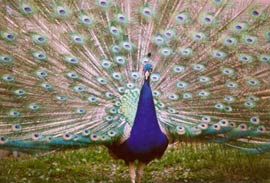Tool Module: Sexual Selection and the Theory
of Parental Investment
Sexual selection is such a distinctive
form of natural selection that it is often described as a separate mechanism.
It occurs in species where the two sexes are strongly differentiated and individuals
compete to attract members of the opposite sex.
Unlike in natural selection,
in sexual selection, the individual’s immediate survival is not at stake,
but rather his or her ability to leave more or fewer descendants. Sexual selection
often promotes the development of secondary sexual attributes, such as the extravagant
plumage of certain birds.
Darwin was fascinated by the tail of the peacock.
He wondered how natural selection alone could have resulted in a tail so large
that its weight nearly threatened the bird’s survival. The answer Darwin
proposed was that this tail might have been the result of the selective pressure
exerted by females seeking those male partners who displayed the greatest strength
and vigour. Since Darwin’s time, the male peacock’s tail has become
the archetypal example of sexual selection.
 |
Sexual selection is recognized as operating in two ways. In the first, intersexual selection, females and males seek partners with the most attractive attributes. These attributes may be physical (such as the peacock’s tail) or behavioural (such as the courtship dances performed by some birds). In the second, intrasexual selection, competition is encouraged between individuals of the same sex (for example, when two males fight over a female). Another example of intrasexual selection is the dominance hierarchies that form in many species and that give the highest-ranked individuals preferred access to the opposite sex.
 |
Another important concept is that of reproductive effort, meaning the
time and energy that an animal spends to reproduce. Here too, there is a useful
distinction, between mating effort (the energy devoted to finding
and seducing a partner, or to fighting to drive off rivals) and parental
investment (the time and energy that parents invest in raising their
young and the risks that they incur to protect them).
Many factors, varying
from one species to another, help to determine which sex will make the greater
parental investment. But since in many cases this will be the female (producing
only one egg at a time, going through pregnancy, nursing her young, etc.), some
very large differences can be observed in the behavioural strategies that males
and females typically employ to choose their partners. Darwin had already observed
this tendency, which has been confirmed many times since: males simply try to
have as many females as possible, while females spend a long time looking for
the best provider before they mate.
In 1972, Robert Trivers systematized
these observations, from which he concluded that the sex that invests the most
in its young will evolve to be more selective in its choice of a partner. Conversely,
the sex that makes the lesser parental investment will develop a more competitive
temperament and display more opportunism in its choice of partners.
 |
A number of evolutionary psychologists, such as David Buss, have conducted
studies which tend to indicate that this pattern may still be present in the human
species. Buss has shown, for instance, that women accord more importance to a
man’s financial prospects and social status, preferring men who are rich
and of high social standing, as well as men who are older than they are. Such
men can make a greater parental investment and thus contribute to the success
of their offspring.
Men, for their part, prefer women who are younger
than they are (age being an indicator of fertility). Men also accord greater importance
to physical beauty (an indicator of health) and to body shape (they prefer women
with a waist-to-hip ratio of less than 70%, another fertility indicator).
Of course, the human cortex, that generator and assimilator of human culture,
adds other criteria for choosing a partner. But these predispositions from our
evolutionary heritage can often still be discerned in our behaviour.
